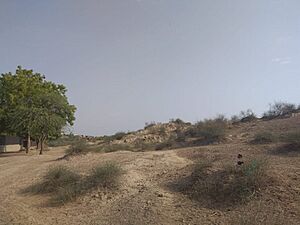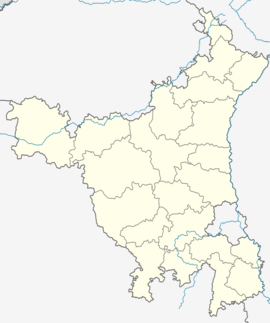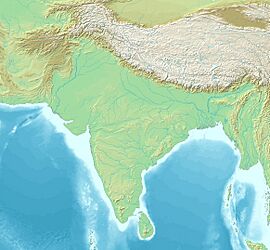Rakhigarhi facts for kids
 |
|
| Alternative name | Rakhi Garhi |
|---|---|
| Location | Haryana, India |
| Coordinates | 29°17′35″N 76°6′51″E / 29.29306°N 76.11417°E |
| Type | Settlement |
| Area | 80–105 hectares (0.80–1.05 km2; 0.31–0.41 sq mi) |
| History | |
| Cultures | Indus Valley civilization |
| Site notes | |
| Excavation dates | 1963, 1997–2000, 2012–2016, 2021–present |
Rakhigarhi (also called Rakhi Garhi) is an ancient village and an important archaeological site in Haryana, India. It is about 150 kilometers (93 miles) northwest of Delhi. This site was once a big city of the Indus Valley Civilisation.
Rakhigarhi was part of this ancient civilization during different times. These include the early period (7000-3300 BCE), the developing period (3300-2600 BCE), and the main period (2600-1900 BCE). It was one of the largest cities of its time. Most experts believe it covered an area of 80 to 100 hectares (about 200 to 250 acres).
Archaeologists started digging here in the 1960s. More digs happened in the late 1990s and then more regularly in the last ten years. Scientists have even studied ancient DNA from skeletons found here. This helps us learn about the people who lived in Rakhigarhi thousands of years ago.
Exploring the Ancient City
Where is Rakhigarhi Located?
Rakhigarhi is in the Ghaggar plain, about 27 kilometers (17 miles) from the Ghaggar river. Today, it is a small village in Haryana, India. Experts think Rakhigarhi was in the valley of an old river called the Drishadvati River. This river started in the Siwalik Hills.
How Big Was Rakhigarhi?
Many experts, like Gregory Possehl and Jonathan Mark Kenoyer, agree that Rakhigarhi was between 80 and 100 hectares in size. This makes it a very large ancient city.
Archaeologists have found many mounds at Rakhigarhi. These are like small hills where ancient buildings and objects are buried. There are at least 11 mounds, named RGR-1 to RGR-11. Some of these mounds are connected, while others are separate. Some experts believe Rakhigarhi might be the largest Indus Valley Civilisation site, even bigger than Mohenjo-daro.
How Old is Rakhigarhi?
Scientists use methods like carbon dating to find out how old things are. The earliest settlements at Rakhigarhi might be even older than the main Indus Valley Civilization.
Different parts of Rakhigarhi are from different time periods. For example, mound RGR-6 has layers from about 5,640 to 5,440 years ago. Mound RGR-1 and RGR-2 have items from the Early Harappan period, about 5,200 to 4,570 years ago. Mound RGR-2 also has items from the Mature Harappan period, about 4,040 to 3,900 years ago. A burial site (RGR-7) is from the Mature Harappan period, about 4,600 years ago.
Nearby Ancient Sites
Rakhigarhi was a big city and a trade center. Many other Indus Valley Civilisation sites are nearby. These include Bhirrana, Kunal, Siswal, and Kalibangan. These sites are in Haryana, Rajasthan, and Punjab, along the old Ghaggar-Hakra river.
Other important sites in this area are Balu and Banawali.
Digging Up the Past
When Were the Excavations?
Archaeologists have been digging at Rakhigarhi for many years. The first digs happened in 1963. Then, more excavations took place from 1997 to 2000. More recently, digs happened from 2011 to 2016 and from 2021 onwards.
Only a small part of the site has been dug up so far. There are 11 mounds, but one (RGR-5) has a modern village on it, so it cannot be excavated.
What Did They Find?
Archaeologists have found many amazing things at Rakhigarhi. These discoveries show us what life was like in the Early and Mature Harappan periods. They found human skeletons, strong walls, and ancient bricks.
A Well-Planned City
The excavations show that Rakhigarhi was a very well-planned city. It had paved roads that were about 1.92 meters (6.3 feet) wide. There was also a good drainage system to carry away wastewater. They had large systems to collect and store rainwater.
Archaeologists found many artifacts, some over 5,000 years old. These include terracotta bricks, statues, and items made of bronze and precious metals. They also found beautiful jewelry. This jewelry included bangles made from terracotta, conch shells, gold, and special stones.
They found pits surrounded by walls. These might have been used for special ceremonies. There were also brick-lined drains for sewage. Other finds include terracotta statues, weights, bronze tools, combs, copper fish hooks, needles, and terracotta seals. One bronze pot was even decorated with gold and silver. They found a gold workshop with many unpolished stones and tools for polishing them.
The Granary
Archaeologists found a large granary from the Mature Harappan period (2600 BCE to 2000 BCE). A granary is a building used to store grain. This one was made of mud-bricks. It had seven rectangular or square rooms. They found traces of lime and grass on the walls. This suggests that lime was used to keep insects away, and grass helped keep moisture out. Its large size suggests it was a public granary or belonged to important people.
Tools and Toys
Many tools were found, like copper tools for hunting and fish hooks. They also found many toys, such as small wheels, tiny lids, sling balls, and animal figures. This shows that toys were common in their culture.
Signs of trade were also found, like stamps, jewelry, and weights made of 'chert' stone. These weights were similar to those found at other Indus Valley sites. This means they had a standard system for weighing things.
Culture and Daily Life
Archaeologists found fire altars and special structures that might have been used for worship. Traces of cotton cloth were found on silver or bronze objects. Many impressive stamp seals were also discovered at Rakhigarhi.
Ancient Burial Sites
A cemetery from the Mature Harappan period was found at Rakhigarhi. So far, 53 burial sites with 46 skeletons have been discovered. The graves were often covered with bricks. In one case, a wooden coffin was found.
Most skeletons were lying on their backs. Some were lying on their stomachs. Some graves were simple pits, while others were lined with bricks and contained pottery. Some graves also had pots with animal remains, which might have been offerings for the dead. Scientists are studying the bones and DNA from these skeletons to learn more about the ancient people.
Skeletons Tell Stories
In 2015, four complete human skeletons were found in mound RGR-7. These included two adult males, one adult female, and one child. Pottery with food grains and shell bangles were found with them.
Two of the skeletons, a man and a woman, were found buried together. They were placed side by side, with the man's head facing the woman. This special burial suggests they had a close bond. Pots found in their grave likely held food and water as offerings. An agate stone found near the man's collarbone might have been part of a necklace. The man was about 177 cm (5 feet 10 inches) tall, and the woman was about 171 cm (5 feet 7 inches) tall. They seemed healthy when they died.
Scientists have studied the DNA from one skeleton. The results help us understand where these ancient people came from. By 2016, 61 skeletons had been found. Archaeologists hope that new technology will help them learn what the Harappans looked like 4,500 years ago. The average height was about 175.8 cm (5 feet 9 inches) for men and 166.1 cm (5 feet 5 inches) for women. In 2024, 56 more skeletons were found in Mound 7.
Protecting Rakhigarhi
An Endangered Site
In 2012, Rakhigarhi was named one of the most endangered heritage sites in Asia. It faces threats from new buildings, poor management, and people stealing artifacts. A study in 2012 found that the site was not well protected. Parts of the site are being damaged by soil erosion, illegal building, and theft of ancient objects. It is against the law to sell or buy artifacts found at ancient sites. Sadly, a large part of two mounds (RGR-6 and RGR-7) has been damaged by farming and soil removal.
Houses on the Site
Some villagers have built houses on parts of the ancient mounds, specifically R4 and R5. The government only controls a small part of the large site because of these buildings and ongoing court cases.
Saving and Preserving Rakhigarhi
In 2020, the government announced that Rakhigarhi would be developed as an important heritage site. Plans are in place to remove the houses built on the mounds. The villagers whose homes are removed will be given new homes in another location.
Museum and Lake
Rakhigarhi now has a museum built by the state government. This museum displays many of the amazing objects found at the site. There is also the Haryana Rural Antique Museum nearby, which shows the history of farming and old village items.
To make Rakhigarhi a global heritage site, two water bodies (called johad) near the museum are being turned into lakes. The lakes have been made deeper, and traditional steps (ghats) with small towers (burji) have been built along their banks. A park has been created around the lake, with walking paths and shady trees. These ghats remind us of the past when the ancient Drishadvati river flowed through Rakhigarhi. Back then, ghats were used for trading goods, which traveled all the way to ancient Mesopotamia.
See also
- Indus Valley civilisation related
- List of Indus Valley Civilization sites
- Mohenjo-daro
- Bhirrana
- Kalibanga
- Kunal
- List of Indus Valley Civilization sites
- Rakhigarhi Indus Valley Civilisation Museum
- History of Haryana




